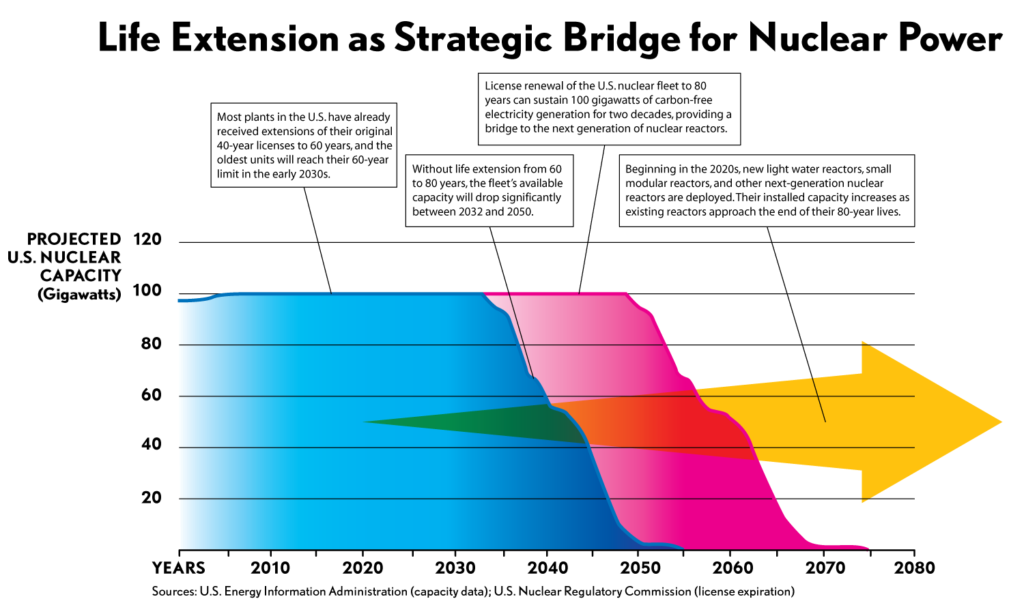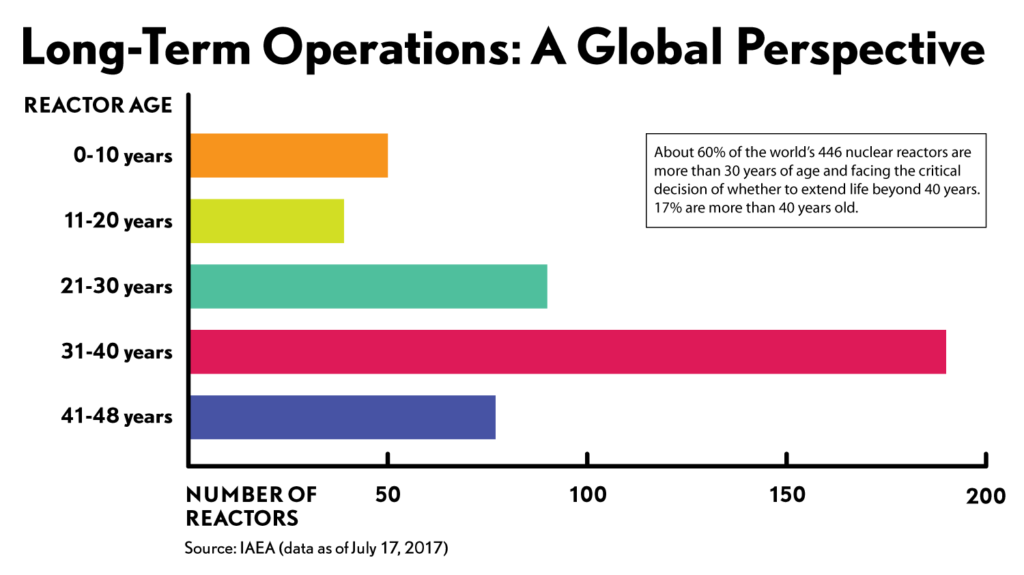The nuclear fleet in the United States has reached a milestone. The U.S. Nuclear Regulatory Commission (NRC), which originally licensed plants to operate for 40 years, has now approved 20-year license extensions for more than 75% of the fleet, enabling operation to 60 years. The fleet is now moving forward with plans for a second round of license renewals (which the NRC calls “subsequent license renewals”) to allow operation out to 80 years.
Two utilities have announced their intent to submit applications for this second round. In 2018 Exelon expects to submit an application for its 2,800-megawatt Peach Bottom Atomic Power Station (two boiling water reactor units), and Dominion Energy expects to submit for its 1,600-megawatt Surry Power Station (two pressurized water reactor units) in 2019.
License renewal involves a systematic review of the plant, identification of degradation mechanisms, and the development of aging management programs. It proceeds through coordinated efforts on two distinct fronts—regulatory and technical. Participants in regulatory activities include electric utilities, the NRC, and the Nuclear Energy Institute. Technical work is being conducted by EPRI, U.S. Department of Energy (DOE), the national energy research laboratories, several universities, and the International Atomic Energy Agency.
Absent the second extensions, U.S. nuclear units will retire as they reach the end of their 60-year lives, and U.S. nuclear generation would begin a steep downward slope in the early 2030s. By 2035, approximately 30,000 of today’s 100,000 megawatts of nuclear capacity would be offline. By 2050, the current light water reactor fleet would be nearly gone (see graphic below).
The second round of license renewals represents a bridging strategy. It can potentially sustain a large source of carbon-free generation for an additional 20 years until deployment of the next generation of nuclear power units, including new light water reactors, small modular reactors, and other advanced reactor designs.

A Solid Foundation for the Second Round of Renewals
In 2014, the NRC concluded that the second round of license renewals can use the existing regulatory framework without rule changes, directing its staff to update license renewal guidance.
“This is a very positive result for the industry for a predictable review and approval process,” said Mark Sartain, Dominion Energy’s vice president of nuclear engineering.
In 2015, the NRC staff issued a draft report that provides aging management guidance for plants seeking to operate from 60 to 80 years. Referencing more than 125 EPRI studies, the document establishes the technical basis for the second round of license renewals. (An earlier NRC document called the Generic Lessons Learned Report identifies and reviews nuclear plant aging management programs acceptable for first license renewals from 40 to 60 years.)

No Technical Showstoppers
Established in 2008, EPRI’s Long-Term Operations Program provides research and technical basis that can inform utilities’ license renewal efforts and aging management programs. It draws on a broad body of technical expertise and decades of research in materials, engineering, and plant operations.
“We’ve been actively working with Dominion Energy and Exelon so that our technical results can inform their decisions and preparations for anticipated license renewals,” said EPRI Senior Program Manager Sherry Bernhoft. “Long-term operations focuses on the components that are most critical to safety and hardest to replace: the reactor pressure vessel, reactor internals, large concrete civil structures, and the cable-supported nervous system of the plant. Replacing any of these components would most likely be cost-prohibitive and lead to plant closure.”
Life extension to 80 years is technically feasible. “From all the research undertaken so far, we have not found a technical showstopper that would prevent a plant from operating safely for 80 years,” said Bernhoft. “The caveat is that plant owners and operators will need to update and implement aging management programs for the critical components.”
Effective aging management requires an understanding of the aging mechanisms and when and how to inspect, along with thorough evaluation of inspection results and good repair/replacement decisions.
“Just like with your own health, you inspect important areas more and take commensurate preventative measures as plants get older,” said Bernhoft.
EPRI’s long-term operations research focuses on:
- Neutron embrittlement of reactor pressure vessels
- Irradiation impacts on reactor vessels’ internal components or “internals”
- Concrete degradation as a result of alkali-silica reactions and radiation
- Degradation of electrical cables and cable monitoring tools
Aging of Metals
Of greatest concern in a reactor pressure vessel is the possible reduction of its fracture toughness as a result of high fluence and high temperatures. For monitoring, irradiation surveillance capsules are placed inside, then periodically removed and tested. Extensive knowledge of embrittlement trends can be used to predict material properties out to 80 years of operation.
“We continue to monitor reactor pressure vessels, but there is nothing to indicate that the plants are not safe to continue operations,” said EPRI Senior Technical Executive Robin Dyle. Advanced welding techniques such as laser welding and friction stir welding are being developed to repair highly irradiated materials.
Reactor internals operate in a harsh environment with respect to neutron bombardment, water chemistry, and temperatures. “Boiling water reactor operators have been evaluating the impacts longer than the operators of pressurized water reactors,” said Dyle. “Boiling water reactors had degradation of reactor internals earlier in life, and the operators have a well-documented inspection program based on more than 20 years of experience to confirm that components are safe.”
EPRI determined that pressurized water reactors have strong aging management programs as well, but some components have failed. Researchers had anticipated—and confirmed with inspection—that baffle-former bolts could fail due to stress corrosion cracking. The NRC concluded that there is no safety problem, but utilities and EPRI responded by changing inspection protocols to combine visual and ultrasonic techniques during scheduled outages.
Aging of Concrete and Civil Structures
Concrete degradation can occur as a result of irradiation and chemical reactions.
“Silica in the concrete aggregates can be highly reactive with the alkali in the cement, especially at high temperatures and humidity,” said EPRI Technical Leader Sam Johnson. “Alkali-silica reactions form a gel around the aggregate that can stress the concrete and cause cracks, typically in radiating patterns that resemble spider webs. Because of reinforcement, this doesn’t necessarily mean the concrete has lost any of its strength.”
If cracks are large enough, water and chlorides can seep in and cause reinforcement corrosion. Such cracks can be sealed.
Aging management includes monitoring concrete structures around the plant for structural integrity and movement. “Concrete expansion as a result of alkali-silica reactions may cause misalignment of equipment, and we need to make sure alignment is within an acceptable range,” said Johnson.
Inside containment, a key concern is irradiation of the bioshield, a large concrete structure that surrounds the reactor to reduce the effects of neutrons and protect workers. EPRI and others have conducted substantial research on how radiation impacts the concrete. A modeling study of a pressurized water reactor’s bioshield showed that significant structural margin remained after an equivalent of 80 years of irradiation. The upshot: Irradiation effects are unlikely to be a technical challenge for the second round of license renewals.
Aging of Cables
Heat, radiation, and water can accelerate aging of cable insulation. Degradation is typically localized because cables often run through many different environments from beginning to end.
“Some run between buildings—for example, from office and equipment rooms into the turbine building and heater bay,” said EPRI Principal Technical Leader Drew Mantey. “Others run underground, through conduits embedded in concrete susceptible to moisture or through penetrations into containment. Some even run side-by-side with steam lines. Exposure and degradation vary segment by segment.”
In 2009 EPRI, in collaborative efforts with its members, developed aging management guidelines for the three categories of cables, drawing on industry experience and decades of research:
- Low-voltage cables for instrumentation and controls
- Low-voltage cables for motors and equipment
- Medium-voltage power cables, particularly those in wet environments
“The NRC has issued industry guidelines for aging management of cables for the first license renewals from 40 to 60 years,” said Mantey. “To prepare for life extension to 80 years, we brought together experts from the NRC, EPRI, DOE, and the national research laboratories to identify knowledge gaps.”
Led by Mantey, the group assigned areas of responsibility among the participants, with EPRI focusing on medium-voltage cables vulnerable to moisture, including those that run through conduits embedded in concrete.
“To inform cable research, EPRI is measuring radiation and temperature at an operating plant. Do we have to consider both temperature and radiation for predicting degradation, or is one predominant? We should have an answer soon,” said Mantey.
A search for better monitoring technologies is underway. “For medium-voltage cables, we have a good tool known as the very low frequency tan delta test that tells us we may have a problem somewhere along the cable, but not specifically where. And we have tools that tell us we have an anomaly at a particular place on the cable, but not whether it is a problem. We’re developing a new tool that indicates where degradation is a problem along the full length of a cable,” said Mantey.
Surry, Peach Bottom, and Beyond
Surry’s license renewal application remains on schedule for submission in the first quarter of 2019, according to Dominion Energy’s Mark Sartain. “We don’t feel there are any technical issues that cannot be managed through aging management,” he said. “To support our aging management, Dominion Energy has used EPRI research such as inspection guidelines for steam generators, reactor vessel internals, and water chemistry.”
According to Michael Gallagher, Exelon’s vice president of license renewal and decommissioning, it will take the NRC 18 months to review Exelon’s license renewal application for the Peach Bottom plant, which includes on-site audits and inspections, public meetings, and an environmental impact report.
“Exelon will devote approximately 100,000 man-hours to prepare and shepherd through the second license renewal,” said Gallagher.
Together, Surry and Peach Bottom can usher in the second wave of life extension for the entire industry.
“Research on long-term operations by EPRI and its collaborators—coupled with the industry’s success in meeting the requirements of the first round of license extensions—provides a strong technical foundation for the second round,” said Bernhoft. “Experience from Surry and Peach Bottom will help lead the way toward safe license renewal out to 80 years for dozens of other U.S. utilities. Success in the U.S. will help inform international license renewal guidelines and safe operations in countries where nuclear plants are 5–10 years younger.”
Key EPRI Technical Experts:
Sherry Bernhoft, Robin Dyle, Sam Johnson, Drew Mantey
For more information, contact techexpert@eprijournal.com.
Further Resources:
- Methodology and Installation of Radiation and Temperature Monitors: Research for Installed Cables at U.S. Nuclear Power Plants in Support of Long-Term Operations
- Long-Term Operations: Normal Temperature and Radiation Dose to Installed Cable for U.S. Nuclear Power Plants in Containment
- Long-Term Operations: Evaluation of the KEMA Smart Cable Guard System for Online Partial Discharge Detection
- U.S. NRC Guidance for License Renewal
Banner Illustration by Craig Diskowski/Edge Design, Infographics by MCKIBILLO

